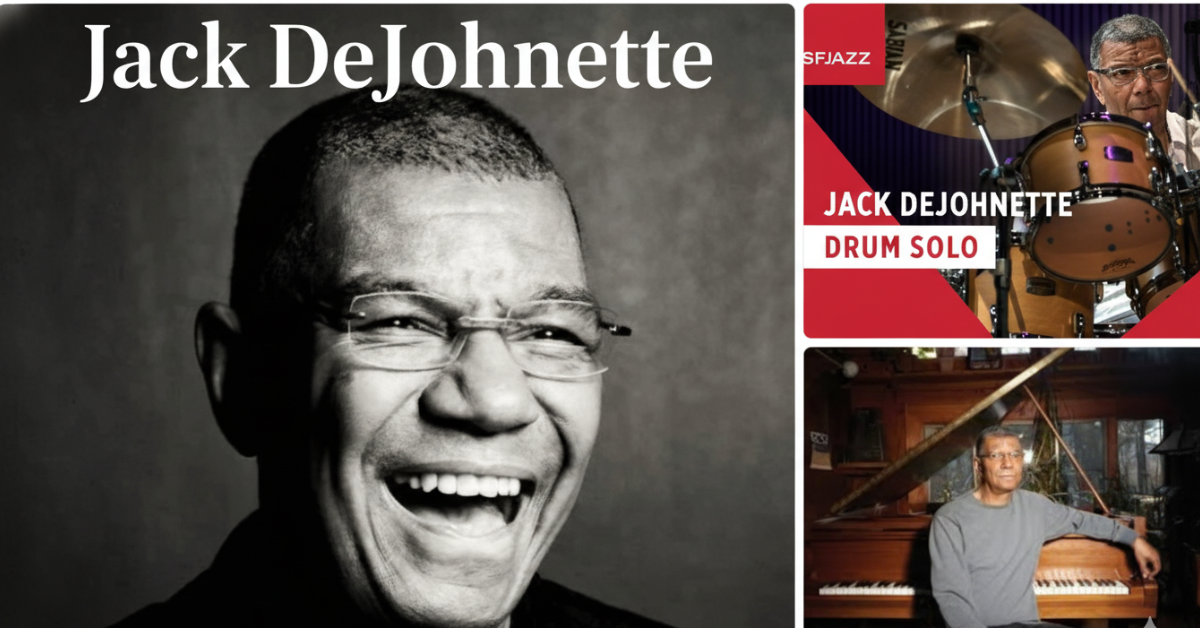Jack DeJohnette is an unequivocal giant of modern jazz—an artist who embodies fusion, improvisation, genre-crossing, and musical invention. Often celebrated primarily as a drummer, his identity is richer: pianist, composer, bandleader, collaborator, and innovator. In this article we will explore his life, artistry, major milestones, and enduring legacy
Early Life and Musical Roots
Jack DeJohnette was born on August 9, 1942, in Chicago, Illinois.
His family environment valued music highly, and DeJohnette began classical piano lessons at age four. He later added drums to his palette, joining his high-school concert band at age 14.
In his youth, he absorbed a wide array of musical styles—classical, R&B, blues, jazz—and as he puts it, “I listened to all kinds of music and I never put them into categories.”
This broad musical openness would become a defining feature of his work.
In Chicago’s vibrant jazz and avant-garde scene of the early-to-mid-1960s, DeJohnette played piano and drums with local groups, R&B and hard-bop bands, and avant-garde jazz collectives like the Association for the Advancement of Creative Musicians (AACM).
Thus, his foundation was built on both formal classical training and street-level jazz improvisation—a rare combination that would shape his melodic and rhythmic sensibility.
jack dejohnette instagram id : jackdejohnette_

Move to New York & Major Early Associations
In 1966, Jack DeJohnette relocated to New York City to further his career.
There, he quickly became part of the jazz scene, working with artists like Charles Lloyd (as part of the Charles Lloyd Quartet), which included pianist Keith Jarrett.
His work during that period (mid‐ to late‐1960s) exposed him to larger audiences and international touring, and he played with major figures including Bill Evans, Jackie McLean, Abbey Lincoln and others.
He made his first recordings as leader/co‐leader around 1968.
From this point, DeJohnette was no longer just an accompanist—he began to forge his own voice.
Breakthrough: Fusion Era & The Miles Davis Connection
One of the most critical chapters in Jack DeJohnette’s career emerged when he joined the band of Miles Davis, becoming a central figure in Davis’s electric/fusion experiments around 1969–72.
DeJohnette replaced Tony Williams and played on landmark recordings like Bitches Brew.
This period positioned him at the vanguard of jazz fusion—combining jazz improvisation, rock rhythms, electric instrumentation and open forms.
His style during this era was distinctive: groove-driven yet fluid; capable of firm rhythmic support but also exploratory colour and texture.
Versatility: Drums, Piano & Composer
Though primarily known as a drummer, DeJohnette maintained his identity as a pianist. He often played piano, organ, melodica and other keyboards in his own projects.
For instance, his 1985 album The Jack DeJohnette Piano Album features him on piano and synthesizer exclusively.
This dual‐instrument capability gave him a broader compositional palette—rhythm, harmony, texture.
As composer and bandleader, he formed ensembles such as Directions, Special Edition, Gateway and more. His albums stretch across hard bop, avant-garde, fusion, world music and more.

Major Albums & Notable Projects
Here are some key recordings in Jack DeJohnette’s vast discography:
-
The DeJohnette Complex (1968) — one of his first leader albums.
-
Special Edition (1979/1980) — hailed as revolutionary in modern improvised music.
-
In Movement (2016) — a trio project with Ravi Coltrane and Matthew Garrison, showing his forward‐looking approach even in later years.
-
The Jack DeJohnette Piano Album (1985) — shows his shift toward piano-led projects.
These projects highlight his explorations across instrumentation, ensemble formats and genre boundaries.
Musical Style & Artistic Approach
Jack DeJohnette’s musical style defies easy categorization—and that is precisely part of his appeal.
Rhythmically, even when playing drums he thinks melodically and harmonically—his drumming is often described as orchestral. He once noted:
“I am hearing orchestrally … the cymbals are to my drum set what the sustain pedal is on the acoustic piano.”
Harmonically & Compositionally, his piano background enables him to think in terms of chords, texture, structure—not just time‐keeping.
Genre‐wise, his work spans R&B, hard bop, fusion, sacral/avant-garde, world music. He refuses to be pigeon-holed.
Collaborative mindset: DeJohnette’s greatness is magnified through collaborations—he’s worked with nearly every major jazz artist from the 1960s onward: Miles Davis, Keith Jarrett, Sonny Rollins, Ornette Coleman, Bill Evans, Pat Metheny and many more.
As a bandleader, he often places the group’s interaction, textural depth and improvisational openness ahead of mere technical display. The result: music that swings, evolves, challenges.
Legacy & Recognition
Jack DeJohnette’s legacy is multi‐faceted.
-
In 2012, he was named a Jazz Master by the National Endowment for the Arts (NEA).
-
He has won multiple awards and been regularly voted Drummer of the Year in major jazz publications.
-
His influence touches drummers, pianists and composers alike—those who see the instrument as part of a larger musical voice.
-
His adaptability means his music continues to be re‐discovered by new generations.
Why He Matters Today
In an era when genres are increasingly fluid, and musicians draw from multiple traditions, Jack DeJohnette stands as a model of musical openness. Here’s why his work remains relevant:
-
Boundary‐crossing: He has always blended jazz with rock, funk, world music, classical and beyond.
-
Instrumental versatility: Drummer but also pianist—pluralism in voice.
-
Collaborative spirit: His work emphasises listening, interplay, ensemble rather than ego.
-
Innovation rooted in respect: He pushes forward but remains deeply grounded in jazz’s traditions.
-
Inspirational trajectory: From Chicago school to global stage, from accompanist to leader.
For Listeners & Aspiring Musicians: Key Takeaways
-
Listen actively: When you hear DeJohnette’s drumming, listen for how he shapes the pulse, colours the sound and converses with his bandmates.
-
Study versatility: Note how his piano work influences his drumming (and vice versa) — rhythm informs harmony and harmony informs rhythm.
-
Embrace diverse styles: Don’t feel limited just to one “jazz style”—DeJohnette’s career shows how many paths there are.
-
Value collaboration: Great music often emerges from real listening and trust among musicians, not just technical fireworks.
-
Lead with curiosity: Whether you’re a drummer, pianist or composer, keep asking “what if?” His career is a testament to staying open and evolving.
Selected Discography Highlights
-
The DeJohnette Complex (1968)
-
Special Edition (1979/80)
-
The Jack DeJohnette Piano Album (1985)
-
In Movement (2016)
-
(For a full discography, see sources)
Conclusion
Jack DeJohnette stands not just as one of jazz’s greatest drummers, but as a full-fledged musical voice: pianist, composer, bandleader and innovator. His journey from Chicago to the global jazz stage, from classical piano student to fusion pioneer, offers lessons in versatility, curiosity and depth.
For anyone seeking to understand modern jazz—not just its history but its living possibilities—his work remains essential. May his rhythms, chords and ensembles continue to inspire listeners and musicians for generations.
“I had formal lessons on piano and listened to opera, country and western music, rhythm and blues, swing, jazz, whatever… To me, it was all music and all great.” — Jack DeJohnette






